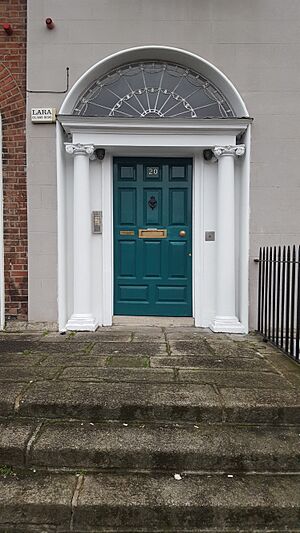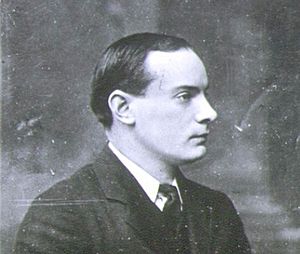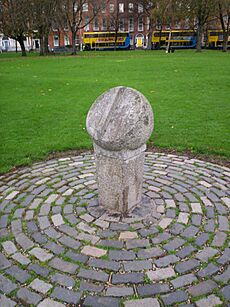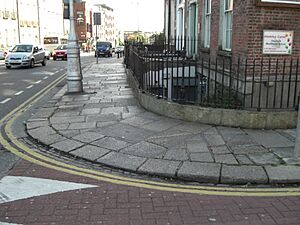Mountjoy Square facts for kids
| Cearnóg Mhuinseo (Irish) | |

Clockwise from top: Mountjoy Square South in the snow of January 2010; a tree decorated with a mosaic in Mountjoy Square Park; Mountjoy Square West
|
|
| Former name(s) | Gardiner Square |
|---|---|
| Namesake | Luke Gardiner, 1st Viscount Mountjoy |
| Area | 2 hectares (4.9 acres) |
| Location | Dublin, Ireland |
| Postal code | D01 |
| Coordinates | 53°21′23.8″N 6°15′27.0″W / 53.356611°N 6.257500°W |
| Other | |
| Known for | Georgian architecture |
Mountjoy Square (Irish: Cearnóg Mhuinseo) is a famous garden square in Dublin, Ireland. It's located on the Northside of the city, not far from the River Liffey. It is one of five special squares in Dublin built in the Georgian style.
This square was planned and built in the late 1700s by Luke Gardiner, 1st Viscount Mountjoy. It is surrounded by beautiful red-brick Georgian houses. Building these houses started in 1792 and finished in 1818.
Over the years, many important people have lived in Mountjoy Square. These include lawyers, church leaders, politicians, writers, and artists. The famous writer James Joyce lived nearby when he was young. Playwright Seán O'Casey wrote some of his plays while living here. W. B. Yeats also stayed with his friend John O'Leary in the square. The Oscar-winning film Once was also filmed here.
Important historical meetings took place in Mountjoy Square. These included plans for the Easter Rising and some of the first meetings of the Dáil, Ireland's parliament. People with different political views, both Irish Unionists and Republicans, have called the square home.
Mountjoy Square is special because it's Dublin's only true Georgian square. Each of its sides is exactly 140 metres long. The North, East, and West sides each have 18 houses. The South side has 19 houses, showing slight differences in plot sizes. The houses are now numbered from 1, going clockwise from the north-west corner.
Contents
How Mountjoy Square Was Built
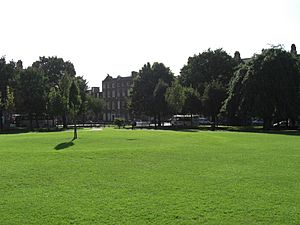
The Gardiner family played a big role in building Mountjoy Square. The first Luke Gardiner, who died in 1755, was a very successful banker and developer in the early 1700s. He bought a lot of land in Dublin, especially on the Northside. He helped develop areas like O'Connell Street and Parnell Square.
His grandson, also named Luke Gardiner, continued this work. He was a powerful person and a member of the Wide Streets Commission. This group helped plan and build new streets in Dublin.
Mountjoy Square was part of this big building project. An early plan for the square, then called Gardiner Square, was made in 1787. Luke Gardiner and the planner, Thomas Sherrard, had big ideas for the square. It was built on high ground, so all the streets leading from it went downhill. It also had a view of The Custom House.
Building started around 1790 on the south side of the square. It continued until 1818. Sadly, Luke Gardiner was killed in 1798 during the Rebellion of 1798, while the square was still being built.
After it was finished, people praised Mountjoy Square. They said it was "neat, simple and elegant" and that its location was "elevated and healthy." They believed it was one of the finest squares in Europe.
In 1825, George Newenham Wright described the square as "small, regular and elegant." He also noted that the air there was thought to be "extremely pure" because it was on high ground at the edge of Dublin.
In the past, the park in the middle of the square was only for residents. But in the 1900s, it was opened to the public. This was a big change, allowing everyone to enjoy the green space.
During the 1900s, many houses in the square became tenements, which are crowded apartment buildings. Some parts of the square fell into disrepair and were torn down. However, new buildings were later constructed with similar Georgian fronts. This helped keep the square looking like a consistent Georgian street.
In 2005, an architecture expert named Christine Casey said that Mountjoy Square has "outstanding" plasterwork inside its buildings. She even said it was finer than the plasterwork in other famous squares like Merrion Square.
Famous People of Mountjoy Square
Many famous people have lived in or visited Mountjoy Square. One of the earliest was Arthur Guinness, who started the famous Guinness brewery. He died there in 1803. Later, his descendant Desmond Guinness tried to help save and restore the square's beautiful character.
Seán O'Casey, a well-known Irish playwright, lived in a tenement house at number 35 Mountjoy Square. He lived there during the Irish War of Independence. It is said that his house was raided by the Black and Tans during this time.
John O'Leary, a leader of the Fenian movement, lived at number 53 Mountjoy Square West. The poet W. B. Yeats was a friend of O'Leary and is known to have stayed at this house.
Important political meetings also happened here. Dáil Éireann, Ireland's parliament, met secretly in a home on Mountjoy Square after being banned by the British. Also, some of the volunteers for the Easter Rising met at Mountjoy Square in 1916 before their mission.

Seán O'Casey set many of his famous plays, like The Shadow of a Gunman, in tenement houses in Georgian Dublin. The house in his play The Shadow of a Gunman is thought to be based on his own home in Mountjoy Square.
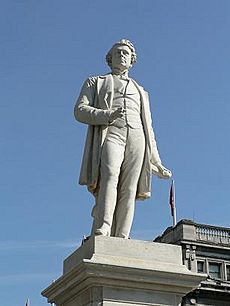
The sculptor Thomas Farrell lived at number 30 Mountjoy Square. You can see two of his sculptures on O'Connell Street. Joe Duffy, a well-known Irish radio presenter, was born on Mountjoy Square in 1956.
The 2007 film Once, which won an Academy Award, had many scenes filmed in an apartment on Mountjoy Square East. The band U2 also used to rehearse in a building on Mountjoy Square in the late 1970s.
Learning and Education
Mountjoy Square is home to several educational places:
- The School of Art, Design & Printing and the Department of Social Sciences of the Dublin Institute of Technology are located at numbers 40–45 Mountjoy Square.
- Public Affairs Ireland is based at 25 Mountjoy Square.
- Dorset College has an office on the corner of Mountjoy Square East.
- The Dublin Adult Learning Centre is at 3 Mountjoy Square.
- CELT Ireland English School is also on the east side of the square.
Things to Do and See
The park in the middle of Mountjoy Square has lots to offer. There are areas for playing football, basketball, and table tennis. There are also playgrounds for younger children and a nice green space to relax. It's also a short walk to the Blessington Street Basin.
Protecting Mountjoy Square's History
In 2012, Dublin City Council officially made Mountjoy Square an Architectural Conservation Area (ACA). This means that the entire area, including all the buildings, is protected. Any changes or work done to buildings in the square now need special permission from the city. This helps keep the historic look and feel of Mountjoy Square safe for the future.
In 2018, there was a plan to restore the park in the center of Mountjoy Square to its original 1837 design. However, these plans were later withdrawn in 2019.
Getting Around Mountjoy Square
Mountjoy Square is very close to Dublin city center and has great transport links. Gardiner Street, a major road, runs along its west side.
Many Dublin Bus routes start or stop at Mountjoy Square. You can catch buses to the southeast and northern suburbs of the city. The 41 bus is a very affordable way to get to Dublin Airport from the square.
In 2009, the Dublin Bikes system was launched. There's a bike station on the west side of Mountjoy Square. This makes it easy for people to rent bikes to get around the city. There's also a "Go-Car" car-sharing service available on Mountjoy Square West.
Old Features of the Square
Over time, some things have been added or removed from the square's streets.
The sidewalks were originally paved with granite stones. While most of these have been replaced with concrete, you can still see some of the original granite paving in certain spots, like the southwest corner.
Many houses on the square still have their original coal holes. These small holes in the street have ornate metal covers. They lead to a coal storage area under the street. This was a clever way to deliver coal easily and cleanly to the houses.
The street lamps on the square have two different designs. The lamps on the outer sides, in front of the houses, are older. They date from the early 1900s when Dublin started getting electric lights. The lamps on the inner side, by the park, have a slightly different design from the 1940s or 1950s.
In the late 1700s, streets were often muddy. To keep dirt out of their homes, people had boot scrapers outside their front doors. Many of these fancy scrapers can still be seen today.
Some houses still have their original wrought iron balconettes, which are small decorative balconies. Others have been replaced with newer ones.
Images for kids
See also
 In Spanish: Plaza Mountjoy para niños
In Spanish: Plaza Mountjoy para niños



